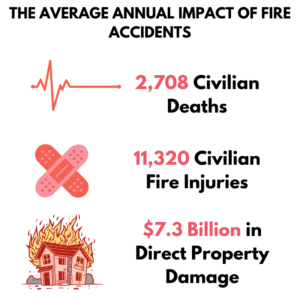Essential Checks and Reviews for Fire Alarm Systems: Accessibility and Monitoring
Fire alarm systems are a requirement and a crucial tool for safeguarding life and property from a fire’s devastating impact.
The Importance of Fire Alarm Systems
Unpredictable and dangerous events of fire pose a significant threat, contributing to a high number of unnecessary deaths in our country every single day. And even if people escape death in these scenarios, there is still a significant impact on the damage that fire can do to property, which is mostly always permanent. The annual average cost of damage that fires directly cause to American property is 7.3 billion dollars.
This is why it’s essential to have preventive measures ready to help us navigate these problems if they ever do occur. Fire alarm systems are a solution that can save billions of dollars and thousands of lives.
Fire alarm systems detect abnormal temperatures in an environment and activate at these times to prevent fires from spreading. The fires are then thoroughly put out. The systems give people time to evacuate safely in dangerous situations while significantly reducing property damage costs.
Some of the main components of a fire alarm system that you want to focus on are the manual call points, accessibility to the pull stations, and monitoring and checking of the fire alarm system through maintenance and testing. Below, we’ll discuss each of these components and the following procedures.

Ensuring Accessibility of Fire Alarm Manual Call Points
What are Manual Call Points?
Manual call points of a fire alarm system are points throughout a building that either have a lever or a button that allows a person to activate the system in an emergency manually.
These points are essential in a building because,
- Immediately activates the smoke management system of the building.
- Activates the alarm and sounds of the whole building about the current emergency, even if the automatic system has failed to do so.
- Alert the exact area in which the fire has taken place.
- Alert the required authorities that a fire has occurred at their location and that they may need assistance if the fire spreads.
- Informs people in the building that an emergency is happening.
- Activates emergency lighting systems that make evacuation easier and safer.
Regulations and Testing
According to the NFPA 72 standard, manual call points have some accessibility requirements that each building must follow, making accessing these points more accessible for people in a fire emergency. Some of these are,
- The call points need to be in a visible and accessible location in the building.
- The location of these points needs to be next to the fire exits and egress paths.
- There must be at least one manual call point for every building floor.
- It should be installed on the floor of an exit door leading to a staircase so that the alarm system knows the exact emergency floor.
To ensure that these manual call points work when needed, they need to undergo some regular testing procedures to ensure they are working. First is the weekly testing of a manual call point in an alarm system. Weekly testing doesn’t mean testing every call point in the building every week, but at least one of them. Make sure to go in a particular order and check every call point in the building over a few weeks before returning to already tested call points.
Next, the call points in the building are mandatorily visually inspected daily to ensure that they are in good physical working condition. If there ever seems to be a problem, the building management must be informed immediately to repair the system.
Finally, a qualified fire inspector should check the entire functioning of the fire alarm system at least once every six months to ensure proper functioning and discover the need for any replacements.
Fire Alarm Manual Pull Station Accessibility Check
What are Pull Stations?
Pull Stations are similar in their functions to call points. They activate alarm systems when automatic systems do not activate themselves due to not detecting smoke, temperatures, or malfunctions.
A pull station is one of two initiating devices for a manual alarm system. Call points are the first type, dual-action boxes requiring two actions, like breaking the plastic cover and pushing the button. Pull stations are single-action alarm boxes that require only pulling the box to activate the alarm system.
Mandated Requirements
The NFPA 101 Life Safety Code states that an individual’s life safety should never depend upon only one safeguard and that additional safeguards must be present in the unfortunate case that other safeguards don’t work properly, explaining the mandatory need for pull stations.
The NFPA 101 standard mandates at least one pull station for an automatic or manual alarm system that detects fire hazards using components such as water sprinklers, heat sensors, or smoke detectors.
Similarly, the NFPA 72 standard also requires specific measurements for the placement and frequency of pull stations in a building. These requirements are also clearly mentioned in the Pennsylvania Code for automatic and manual systems under Code 50.51. Here are the essential requirements of the standards,
- 50.51. Manual system
(a) A manual fire alarm system consists of manual pull stations, signaling devices, power sources, control panels, and other related components designed to notify all building occupants.
(b) Manual pull stations shall be installed on each floor, including basements, penthouses, and equipment rooms. The pull stations shall be installed at each egress point from a floor area within 5 feet of the exit.
(c) The manual pull stations shall be mounted 36 inches and 44 inches above the finished floor.
(d) Noncoded, selective, or zone-coded alarm systems may be installed. When coded systems are used, there shall be a minimum of four rounds of a four-pulse or more code that indicates the area of alarm initiation. The alarm system shall be installed so that simultaneous alarms from different stations or zones will not cause confused or messy code. The maximum number of different audible codes in any facility shall be 150 except where the installation means would permit five or more simultaneously received alarms to sound successive without losing a round from any alarmed station.
(e) All types of manual pull stations shall be wired and connected in such a way so that a single open will only indicate a trouble condition and not initiate a general alarm.
Source: 34 Pa. Code Chapter 50. General Requirements—Buildings. Pennsylvania Code
Reviewing Fire Alarm Monitoring Service Agreements
Fire alarm monitoring service agreements are legal contracts made between a fire alarm monitoring company and a building owner that mention the terms and conditions of the agreement between the two responsible parties and the duties required from each side.
These agreements usually represent companies that promise 24/7 service and immediate responses to a fire alarm emergency. The NFPA states in one of its studies that monitored fire alarm systems can decrease the risk of property damage by up to 50% and the risk of loss of life by up to 82%.
Key Components of A Fire Alarm Monitoring Service Agreement
There are many specific components or requirements that each party would like to lay out so that the expectations of neither party are more than needed. Here are a few essential considerations,
- Both parties will include all the types of services in the agreement.
- Each party will need to follow standard protocols during the total term of the agreement.
- The level agreements of each party.
- Frequency of maintenance testing of the system.
- The total costs and fees for the services over the stipulated period.
Choosing the right service provider for a business is crucial. The more dependable and faster the service responds, the better the chance that a company will save money on property damage and also save lives in a bad situation.
Reviewing Fire Alarm Monitoring Service Agreements
A significant part of a monitoring service agreement is also agreeing to the frequency and level of maintenance that the external service provider will provide. Even ignoring the role of an external influence, general maintenance of a fire alarm system is essential.
Maintenance and testing are the components of ensuring and guaranteeing that a system will work when it needs to and will work 100% effectively. Here’s a comprehensive list of things that you can do to maintain and test your system correctly,
- Test at least one of your manual call points in your system weekly and move on to the others in the coming weeks.
- Make sure that your system is still working daily.
- Calibrate your alarm sensors every week to keep them effectively ready.
- Ensure you do annual system inspections by a verified individual, like a fire inspector.
- Document each inspection and testing of your system for future reference and if it ever needs replacement or repair.
- Get certified evidence of your annual inspections and the state of your alarm system.
- If your fire alarm system has more than 13 zones, test at least one zone weekly.
- Test the connections of the system and the level of power in batteries quarterly.
- Test the alarm indications, sounds, and central control equipment quarterly.
- Also, regularly check for obstructions to your system’s functioning, such as out-of-place furniture.
Following these practices and the abovementioned regulations can help significantly reduce the risk caused by fires in any building infrastructure. It can also help reduce the expenditure that may come with property damage or even fines for not maintaining your system correctly.
Please see our comprehensive guide for a more in-depth look at maintaining smoke detector systems. If you ever need access to customizable checklists used during their maintenance and testing, check out our collection of 500+ checklists, which are instantly downloadable and usable.
Explore more templates
Discover peace of mind with our Fire Alarm Manual Call Point Accessibility Check template. Ensure compliance and safety with this comprehensive guide, designed to streamline your inspection process.
Discover peace of mind with our Fire Alarm Manual Pull Station Accessibility Check template. Ensure compliance and safety by systematically examining accessibility and functionality.
Ensure your fire alarm system is compliant and effective with our Fire Alarm Monitoring Service Agreement Review Checklist.
Ensure your peace of mind with our Fire Alarm Monitoring Service Connection Check Checklist.
Tailored to meet your specific requirements, enabling you to manage
inspections and reports with greater detail and efficiency
ZenFire is a lot more customized to my business. Before I was using a generic app, I could not customize, like I do now."

